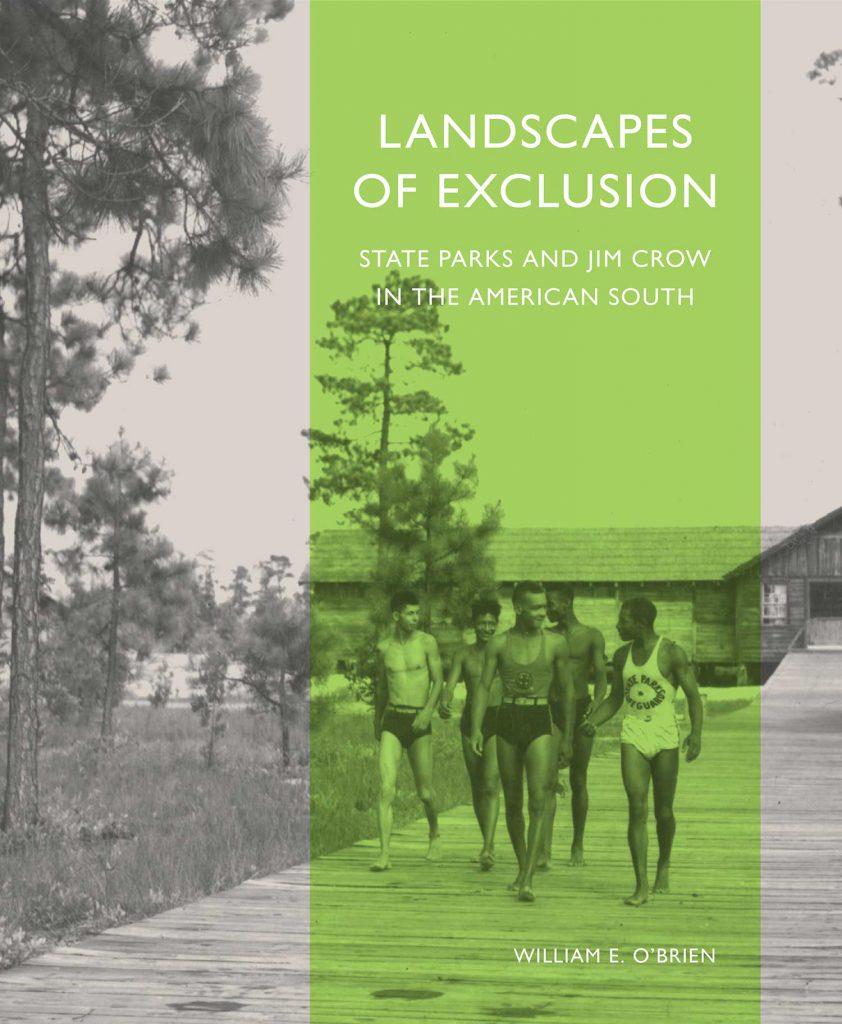Landscapes of Exclusion
State Parks and Jim Crow in the American South
William E. O'Brien
Library of American Landscape History
Paperback Edition
| ISBN: 978-1-952620-35-5 | 208 pages | 8.5 x 10 inches |
| $32.00 | Published: 03/03/2022 |
| 55 b&w photos and maps | |
Cloth Edition
| ISBN: 978-1-952620-24-9 | 208 pages | 8.5 x 10 inches |
| $40.00 | Published: 12/10/2015 |
| 55 b&w photos and maps | |
A volume in the series Designing the American Park
An outgrowth of earlier park movements, the state park movement in the twentieth century sought to expand public access to scenic places. But under severe Jim Crow restrictions in the South, access for Blacks was routinely and officially denied. The New Deal brought a massive wave of state park expansion, and advocacy groups pressured the National Park Service to design and construct segregated facilities for Blacks. These parks were typically substandard in relation to “white only” areas.
After World War II, the NAACP filed federal lawsuits that demanded park integration, and southern park agencies reacted with attempts to expand access to additional segregated facilities, hoping they could demonstrate that their parks achieved the “separate but equal” standard. But the courts consistently ruled in favor of integration, leading to the end of state park segregation by the mid-1960s. Even though it has largely faded from public awareness, the imprint of segregated state park design remains visible throughout the South.
William E. O’Brien illuminates this untold facet of Jim Crow history in the first-ever study of state park segregation. Emphasizing the historical trajectory of events leading to integration, his book underscores the profound inequality that persisted for decades in the number, size, and quality of state park spaces provided for Black visitors across the Jim Crow South.
“O’Brien has completed a remarkable work of scholarship in landscape history that makes it possible for us, finally, to understand this formerly obscured, but clearly significant, category of American parks, those created under the ‘separate but equal’ doctrine.”
“O’Brien’s close study of policy, planning, and design processes offers an unparalleled perspective on how architects, landscape architects, and planners, serving at the behest of local and state officials, designed racially exclusive parks, which in turn created segregated state park systems.”
“O’Brien’s book addresses the omission of race from both landscape architecture and the study of park history, and shows that park design was, like many activities, racially discriminatory. We may not like this history, but it is important to examine it.”
“William E. O’Brien’s Landscapes of Exclusion is required reading for anyone seeking to understand how racial segregation informed park planning practices across the American South. . . . Its sweeping scope and investigation of multiple state systems allow O’Brien to identify the larger patterns that shaped the region and outdoor recreation more broadly.”
“In Landscapes of Exclusion: State Parks and Jim Crow in the American South, a fascinating, deeply researched, and richly illustrated book, William O'Brien tells the story of segregated state parks and recovers a history that states have worked assiduously to erase.”
“Noting the dearth of scholarship on the history of state parks in general, O’Brien combed through a wide array of archival sources, from federal repositories to archives in all of the southern states included in the study. The wealth of his extensive research is revealed in richly detailed case studies of states and parks, utilizing contemporary accounts to describe the arguments both for and against park integration.”
2017 J. B. Jackson Book Prize from the Foundation for Landscape Studies
2017 Award of Merit, American Association for State and Local History
About the Author
William E. O’Brien
William E. O’Brien is professor of environmental studies at the Wilkes Honors College of Florida Atlantic University and a two-time recipient of the University Award for Excellence and Innovation in Undergraduate Teaching. His work on environment and race has appeared in journals including Historical Geography, Geographical Review, Human Ecology, Journal of Geography, and Ethics, Place and Environment.
